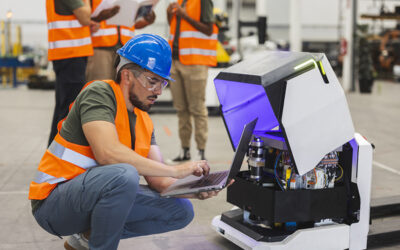Today, businesses aim at speeding up business procedures, delivering a better customer experience, streamlining business operations, and enhancing human worker efficiency. RPA services support businesses in integrating Robotic Process Automation into their existing workflows so that they can reap all the benefits it has to offer without having to make significant changes to their current systems or processes.
Robotic process automation, or RPA, is software that allows businesses to create code sequences that can handle repetitive or tedious operations without the need for human intervention. When it comes to navigating digital networks, this robotic code is designed to work much like humans. They are capable of comprehending complex digital processes, executing seamless workflows, and carrying out a variety of pre-programmed tasks.
Factors That Drive RPA
The increasing desire for enterprises to drive efficiency, minimize waste in business processes, and optimize cost contributed to the exponential expansion of RPA. It also gives non-technical organizations and IT departments with limited resources access to tools which are required to create time-saving automations.
- Before automation optimize your business process: When companies invest in robots to automate their processes, they frequently substitute one type of waste with another. In the rush to implement RPA technology, businesses are rushing to automate their existing processes without first analyzing them or determining where improvements can be made. Investing in RPA technology isn’t just about automating your mechanical processes and freeing up your employees to work on higher-value jobs; it’s also about driving process improvement, which will help the company to grow RPA. Your automation process can be disastrous if you don’t recognize the inefficiencies or waste in a process before automating it with RPA.
- Consider using process mining tools to enhance your workflows: Process mining, which means data mining that detects trends and patterns in event log data, can greatly assist businesses in their efforts to optimize processes prior to automation. Businesses have a plethora of business processes that at first appear to be uniform but, upon closer inspection, differ significantly, complicating the efforts to automate them with a robot. Consider a relatively basic task like processing order forms to pay your suppliers and vendors, which is typically handled by your accounts payable department. Trying to improve and automate order form processing at a multinational firm can soon become entangled in a tangle of multiple situations. The capacity to automate and scale throughout the company is aided by mapping out the steps in a process to truly identify and visualize it. And, it’s only after you’ve created this map of a visual representation of your process, you can improve it.
- Eliminate the Process Design Document: The use of Process Create Documents (PDD) to design, plan, and explain RPA activity is ineffective. They’re usually huge documents that take a long time to put together and don’t capture the precise guidance and precision needed to create bots that don’t break or require continual maintenance. They make it simple to ignore requirements during documentation, and they make it even easier for developers to overlook them when flipping through these dense, illegible documents. To enable RPA at enterprise scale, a unique digital format is required that captures all dependencies as well as the context required to support high-quality RPA development and more robust bots.
- Create an RPA Center of Excellence (CoE) where the business and IT share ownership: One of the biggest reasons RPA programs fail and are unable to scale is siloed RPA ownership. When IT takes sole control of RPA, it becomes isolated from the business and slow to adapt to business needs. When the business is completely responsible for automation, they are unaware of RPA’s technical limits, resulting in poor process selection, mountains of maintenance, and bot mistakes down the road. Only by developing shared ownership between IT and business it is possible to scale RPA. This can be done through an RPA Center of Excellence (CoE). A Center of Excellence (CoE) allows all stakeholders to pool their knowledge to improve process selection, prioritization, and RPA development. The company provides its process expertise as well as higher-level business goals. Simultaneously, IT provides the technical skills needed to guarantee that the necessary operations are automated, avoiding costly maintenance and disruptions in the future.
- Convert your reactive change management strategy into a proactive one: Most of today’s automation teams deal with change in a reactive manner. A bot usually raises an error and stops working because a UI (user interface) element in the system with which the automated process interacts has changed, or a regulation change has gone unnoticed. Teams rush to identify the problem, resulting in extended RPA downtime and a cyclical break-fix methodology that is inappropriate for RPA at scale. Effective, proactive change management is enabled by integrating all key information to your to-be processes for automation. Any time a change is made, an impact analysis can be done quickly and easily, identifying which processes are impacted and where, allowing for proactive change management that reduces RPA downtime and increases productivity.
- Connect all of your processes to higher-level business goals and dependencies:
- Audits become easier and compliance will be better
- Get evidence of how automation is helping to achieve higher-level business objectives
- RPA development of higher quality that accounts for all dependencies, resulting in fewer maintenance difficulties and RPA downtime
- RPA governance that is more effective
- Change management that is proactive
You must integrate all dependencies and key information, such as non-functionals, regulations, legacy systems, business objectives, and so on, to your to-be automated processes in order to drive high-quality bot development that enables RPA at scale.
By connecting all of this vital data to your processes and automating them, you get to enjoy the following advantages:
Having advanced technology that can do more than just assist you to automate a single process is important to establish and manage an enterprise-wide RPA programme. You’ll need a platform that can help you build and manage a new enterprise-wide capability while also assisting you in becoming a fully automated enterprise.
Your RPA system must be able to help you from start to finish, from spotting automation possibilities to quickly constructing high-performing robots and managing thousands of automated workflows. However, integrating RPA into your organization is not easy. Therefore, work with an experienced RPA service provider that can guide your through the process and drive RPA.




